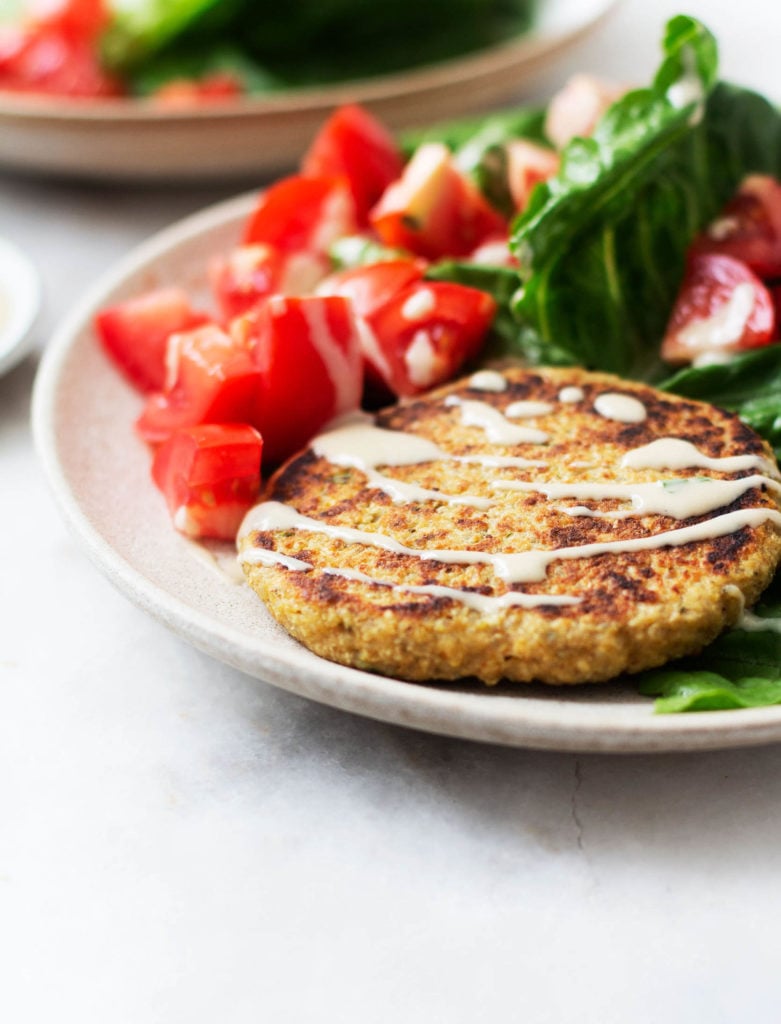
I’ve been resistant to raising the temperature in my kitchen by a single degree. But these quinoa chickpea za’atar burgers were a very good reason to do it!
Between summer and coursework, I’ve barely been cooking lately. What I love about these plant-based patties is that they’re really easy to make. Sure, there’s cooking involved, but it’s pretty streamlined. And you’ll have the option of grilling as well as baking, which saves some time.
Me and veggie burgers: it’s complicated
Believe it or not, veggie burgers are one of the foods I struggle most with. This isn’t to say that there aren’t plenty of recipes that I love. My artichoke, white bean & quinoa burgers, sweet potato chickpea burgers, and unfussy black bean sweet potato burgers are some of my go-to choices for meal prep and batch cooking.
But I’ve also had a ton of flops. Mushy burgers, crumbly burgers, bland burgers, salty burgers—I’ve made them all. Usually, getting a veggie burger right requires lots of different components and fine tuning. These quinoa chickpea za’atar burgers were a welcome change. They came together without much fuss, and their texture held up really nicely.
Quinoa chickpea za’atar burger ingredients
Za’atar spice
The flavorful twist in this dish is za’atar spice. Za’atar is a blend of sumac, thyme, oregano, marjoram, sesame, and salt. Sometimes, pine nuts or cumin are mixed in. The flavor is hard to sum up, but I guess I’d call it both savory and slightly lemony, thanks to the sumac.
I’ve long hoped to experiment with a homemade za’atar blend. Until I do, it’s possible to find za’atar in Middle Eastern markets and even in mainstream grocery stores.
Chickpeas
The chickpeas in this recipe should be cooked when you start. You can use canned or soak and cook them yourself! If you’re out of chickpeas, try using white beans in their place.
Quinoa
I use white quinoa in this recipe, but red or black quinoa will work well. The fact that quinoa is a gluten-free grain makes this a good recipe for sharing with GF eaters. And the complete protein in quinoa is a good nutrition bonus, too!
Tahini
The tahini dressing served with the quinoa chickpea burgers serves a lot of purposes. It’s a saucy component, every bit as essential as ketchup with a regular burger. It also adds brightness and acidity to the dish, picking up the lemony flavor in the za’atar. I use tahini made from roasted sesame seeds, which I think has a milder and smoother flavor than raw tahini.
Prepping and storing quinoa chickpea za’atar burgers
My second favorite part of making these burgers—eating them was first—is the fact that they gave me leftovers! Having leftover plant proteins at home is essential in these busy student days.
The burgers can be stored in an airtight container in the fridge for up to five days. If you need to store them longer, you can freeze them for up to six weeks. To make the meal prep process easier, try cooking the quinoa in advance. It’ll speed up the burger-making process a lot!
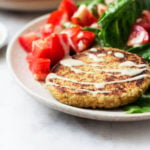
Quinoa Chickpea Za'atar Burgers
Author -Ingredients
For the burgers
- 1 cup quinoa, dry
- 1 3/4 cups water
- 1/2 cup pumpkin seeds, raw or toasted
- 1 3/4 cups cooked chickpeas (1 can, drained and rinsed)
- 1 tablespoon tahini
- 2 tablespoons freshly squeezed lemon juice
- 1/4 cup sun-dried tomatoes, oil packed or dry and rehydrated with hot water, then drained
- 1 tablespoon za'atar spice
- 1/2 teaspoon fine sea salt
- 2 tablespoons chopped green onion tops or chives
- 1 small garlic clove, minced
- freshly ground black pepper to taste
- lettuce leaves, pita, or burger buns, for serving
For the tahini sauce
- 1/4 cup tahini
- 1 tablespoon freshly squeezed lemon juice
- 1 tablespoon apple cider vinegar
- 3 tablespoons water
- 1/2 teaspoon maple or agave syrup
- 1/2 teaspoon ground cumin
- 1/4 teaspoon ground coriander
- 1 tablespoon tamari or soy sauce
Instructions
- Preheat your oven to 375F and line a baking sheet with parchment. Rinse the quinoa the quinoa with cold, running water through a fine sieve. When the water runs clear (after a minute or two) drain the quinoa. Place the quinoa in a pot with the water. Bring the mixture to boil. Reduce the heat to low. Simmer the quinoa, covered, for 13 minutes, or until all of the water has been absorbed. Remove the quinoa from heat. Allow it to sit for five minutes before fluffing it with a fork and setting it aside.
- Place the pumpkin seeds in a food processor fitted with the S blade. Grind them to a fine meal. Add the chickpeas and quinoa. Pulse to combine well. Add the sun dried tomato, tahini, lemon juice, za'atar spice, salt, pepper, garlic, and chives. Pulse continually, until the mixture has all come together. Add water if the mixture is very dry; it should hold together firmly when squeezed together, neither very crumbly nor wet.
- Shape the mixture into 4-6 patties. Bake for 30 minutes, flipping halfway through. Alternately, you can grill or pan fry the patties for about 3-4 minutes per side, till crispy.
- To make the tahini sauce, whisk or blend all ingredients together till smooth, adding a tablespoon of water if the dressing is very thick. Serve the burgers on toasted buns, pita, or in lettuce wraps, drizzled with the dressing.
Any fans of Za’atar spice out there? If so, I’d love to hear how you use it, and whether or not you make your own. In the meantime, hope you’ll like the way it seasons these vegan quinoa chickpea za’atar burgers.
Plant-based, nutritious, flavorful, and make ahead. These days, that’s the best kind of recipe I can think of! With that, it’s back to listening to the thunder that I’m hoping will cool D.C. down. Goodnight, friends.
xo
This post may contain affiliate links. If you use these links to buy something I may earn a commission. Visit my privacy policy to learn more.
Method: Oven
Ingredients: Chickpeas, Quinoa
Dietary Preferences: Gluten Free, Soy Free, Tree Nut Free, Vegan
Recipe Features: Meal Prep

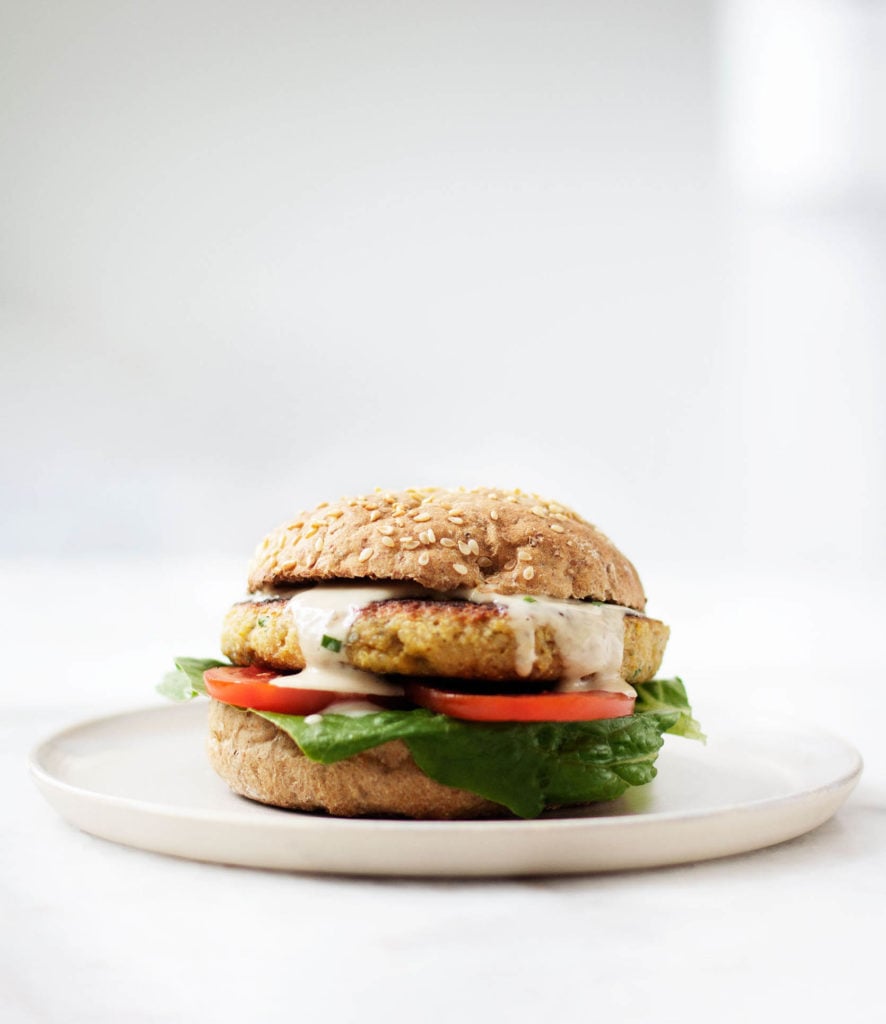
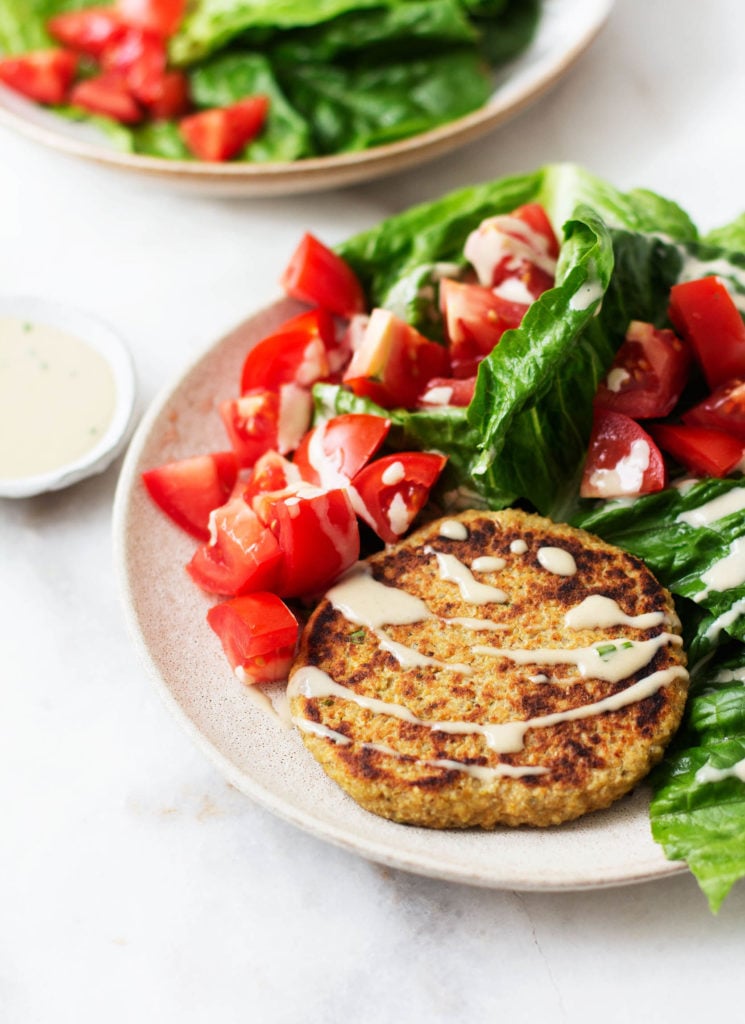
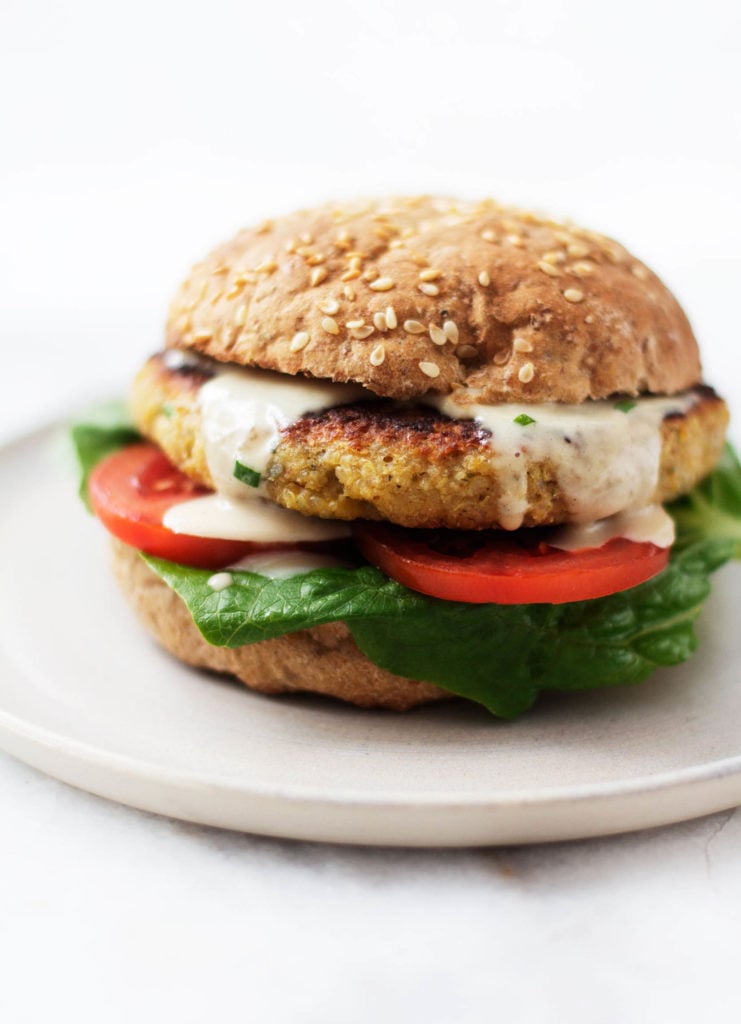
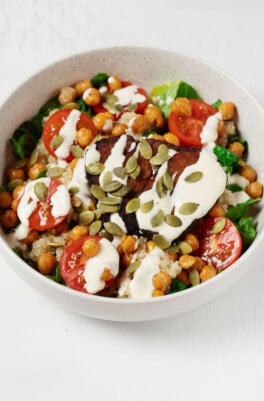
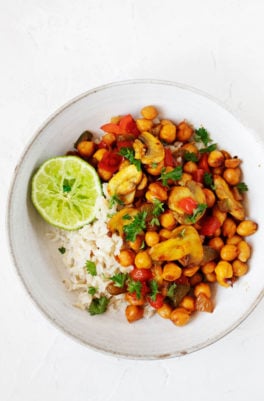
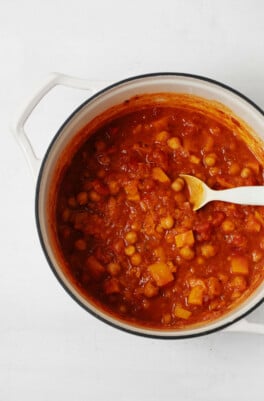
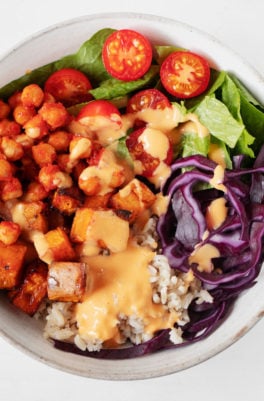
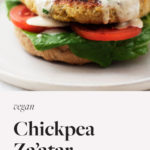
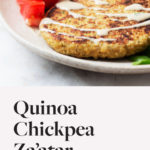
Leave a Comment
These were delicious! The sundried tomato gave it such a rich flavor! Thanks!
I make my own blend, to which I sometimes add sumac and other times not, depending on my mood and the other flavors involved, consists of :
¼ c. sesame seeds, gently toasted in a small skillet over medium heat,
1 T. dried marjoram leaves, crumbled
1 T. dried thyme leaves, crumbled
2 tsp. salt
I rub the herbs between my hands to release the flavor. I don’t often use dried herbs, but they’re essential for this. (I dry my own, so they’re very fresh, though dried.) For a totally non-authentic touch, I sometimes add a bit of freshly grated nutmeg, which gives it a Bavarian twist. ;o)
Just made these, they were delicious, loved the texture and spicing! I ended up with 8 rather large burgers though rather than 4-6, not that I am complaining…more for the rest of the week 🙂
So glad you enjoyed them!
Oh, haha, just realized these burgers are being billed as “soy-free” too which also is negated by the Nama Shoyu.
Try coconut aminos if the flavor is that necessary. But otherwise these are NOT gluten- nor soy-free.
Just a caution, whether you are eating gluten-free or advertising these as gluten-free, many Za’atar spice mixes have wheat in them as does the one from NUTS, and Namu Shoyu is a soy sauce which despite being called “soy” and despite being considered raw (which it is not, the soy is cooked, as it has to be — it is merely fermented and that will be lost in the cooking of these burgers) is very much a wheat based (therefore gluten) product. This therefore is not a gluten-free recipe. It would not be good for those trying to avoid gluten, and especially not for those trying to make something that is “gluten-free” for a guest (it is why we are so damn picky about what others make us even though we wish to be grateful for their thoughtfulness but it just isn’t worth being sick anymore).
Tamari is a better choice for gluten issues though there are other choices as well.
Also, both the quinoa and the chickpeas could be sprouted for additional nutrient loading up.
Simone,
There is actually not much peer reviewed, published scientific research on cooked vs. sprouted grains and legumes, and I personally find the taste of raw grains and beans to be inferior, plus I find them both very hard to digest. But you are absolutely welcome to sprout!
And I’m sorry for the innacuracies. The dressing recipe is an old one, made well before I started modifying my recipes to be GF for my readers (and educating myself). I’ve modified it to say tamari, and I’ve also noted that soy free eaters should use coconut aminos. I’ve also updated my text to say that GF eaters should seek out a GF za’atar spice, and I’ve noted that the Nuts brand is not GF. I really appreciate your helping me to keep this information accurate. I’m not GF myself, but I do want to offer my many GF readers options, and as someone who is mindful of her food myself, I can understand your very understandable pickiness.
Gena
Gena, I really do appreciate your willingness to hear and to make changes. Big Kudos!
However, not meaning to get all nit-picky on you but…
I’ve rarely seen raw tahini. Most use toasted seeds and then it is jarred or canned under heat. I’ve only seen the raw in co-ops (good) and a couple brands in London (UK), one of which was horribly awful, disgusting, horrendous, close to the worst thing ever, nearly destroyed my dish (a good lesson on always taste-tasting ingredients before adding) which was under the Brand, “RAW” ironically. Also, apple ciders are usually not considered raw either unless specified as unpasteurized and given the pesticide/biocide load of apples, organic is probably best there too.
I don’t think I agree with you on the studies of sprouted. However, given that most so-called “scientific” studies are funded by vested-interests such as corporations or drug companies, it often wouldn’t matter to me what they have to say unless it was to, not just ignore their advice but, do the opposite — especially given that so-called “peers” are just as susceptible to influence such as members from the former ADA being paid consultancy fees to give “free” advice on how to make Hershey’s chocolate part of a good diet — I know from what knowledge there is out there as well as my, and my own peers, experiences that soaked and sprouted seeds, nuts, legumes, and grains are much preferable for many reasons.
However, I do not understand the idea that there is an either/or choice laid out here by me or anywhere else. Yes, they can be eaten sprouted and then no further processing… such as the quinoa which sprouts overnight and makes a great substitute for bulgar in tabouli — but I didn’t specify that above. I personally have found, with chickpeas especially that soaking and then sprouting for two days not only improves the flavor and texture by great amounts (as well as cutting down on the cooking time) it improves the digestibility in numerous ways to the benefit of both the eater and those around him/her. This is because it rids these legumes (and temperate nuts) of the enzyme inhibitors that protect them from trying to grow at the wrong times of year and from being overeaten by predators so there are ones left to sprout up when it gets wet in spring.
For the record, I don’t care for raw sprouted legumes either. However, traditional falafel uses soaked chickpeas or favas which are then ground and then fried, not cooked prior. Many Indian dishes are the same. I couldn’t wrap my mind around that when first learning it because my cooking habits were so socialized.
You may also be interested to know that there are no independent studies really that definitively show dairy is good for bones or overall general health (it’s all just been PR smoke & mirrors), but the calcium in the sesame seeds that make up the tahini is quite high and likely better as there is no animal-based protein to throw off the blood ph causing leaching of calcium from the bones to counteract it. However, the reason raw tahini specifically is preferable is that toasting the seeds causes rancidity of the oils which can be carcinogenic.
Food is complicated… even without the vested-influences. 🙁
Also, the sesame seeds in the za’atar mixes are most probably also toasted…
~~
Again, super work on making the quick changes, and thanks for providing interesting vegan (therefore low allergenic) recipes and ideas.
My favorite raw tahini is this one: http://www.livingtreecommunity.com/store2/product.asp?id=10
They’re a lovely company, too.
I just made these last night for a non-plant based diet eating friend and she LOVED them. Hearty and filling, but still light and healthy. Such a success, I’ll definitely be making them again soon (and munching the leftovers for lunch!) 🙂
I know what you mean about burgers falling apart – I struggle with getting the balance between crumbling and just a mouthful of stodge! These look lovely – like hummus in a burger.
As for Za’atar – I don’t use it but saw a place opening up called Za’atar and was amused by a friend who thought it was run by the Za’atar family
Just stopping by again to say that I made these tonight and they are awesome! We served them with tahini sauce and an avocado and tomato salad. I’m already planning to make your sweet potato chickpea burgers next weekend. 🙂
Zaatar is a natural with hummus. Of course it is great with Jerusalem style hot sesame bagels, where zaatar is handed to you in a rolled up newspaper as a condiment. Yum.
Looks very good,.Cannot wait to try it tomorrow! Thank you very much
This looks delicious. The salad looks awesome, please what is the parmesan cheese looking shreds on top?
Spiralized zucchini 🙂
Love the idea of serving the patty on a lovely, thick slice of tomato!! Thanks for thinking of gluten-free folks 🙂
Oh, those look good. And it just so happens that I have some of that spice which has been sitting around, waiting for the perfect recipe! I like all of the ingredients in the patties; can not wait to try it out!
I never have sandwiches or burgers anymore since I have gone gluten free. This looks amazing and I can’t wait to try it!!! Thanks again!
Hi Gena,
Do you use the sundried tomatoes dry or are they water or oil soaked?
I absolutely love your blog. A mix of raw and vegan food saved me from multiple food sensitivities and your blog helps to keep me inspired.
Thanks so much!
Good question! Soaked.
I’ve only used Zataar like my gma showed us: mixed with olive oil, spread on pita, and toasted till hot. But I’ve noticed a lot of blog recipes using it in new ways. I think using it as a seasoning In a chickpea recipe seems like a safe transition for me. Thanks for the recipe!
Just made a double recipe of these to take to lunch this week! I couldn’t find zaatar so I used your substitution and they turned out great. The “batter” was so tasty I almost didn’t cook them but it was totally worth it. Thanks gena! 🙂
Fantastic! So glad.
These burgers look great – I can’t wait to make them and see how they hold up in my freezer! Maybe this weekend. I have a crazy week coming up at work and it would be good restock the freezer with some healthy burgers. Zaatar is great on hummus, too. That’s one of my favorites!
I am a fan of anything that can be made in a food processor (no real dishes) and requires little supervision. This looks great. I am thinking that a spicy mango chutney would be the ideal condiment. I’m gluten-free, and would put this on a slice of rye sourdough.
Chickpeas -check. Quinoa -check. Za’ataar sounds super exciting. And no need for eggs/breadcrumbs to mess around to bind it? I’m there!
I’ve never had great success with meat-free burgers but I’m inspired to try these 🙂
I love za’atar, and am super excited to try it in these chickpea quinoa burgers! Maybe with some quick sumac red onion pickle…
I love your first line. & totally agree. Nothing like an apple, orange, or banana for a quick bite!
YUM! These look amazing, can’t wait to try! (and thanks for the special gluten-free version, tomato-style 🙂 I made veggie burgers last night using cooked millet and amaranth flour and other veggies, let me know if you want the recipe to tweak à la Choosing Raw for the future 🙂
Do you happen to have a good Socca recipe by any chance? Or other gluten-free summer tarts or “pizza” recipes using chickpea flour? I’ve been experimenting, but I usually prefer your recipes, so let me know if you have any ideas!
David Lebovitz’s recipe is great! I haven’t really explored socca much, but I know that one is a winner 🙂
These look so delicious Gena! I was planning on making some sort of burger this weekend to go with some grilled veggies and this one looks amazing. I have everything except nama shoyu!
Hope you enjoy, Wendy!
These look fantastic! I’m on the hunt for the world’s best veggie burger and have still yet to find it. Maybe this will be the one? 😉
That’s a lot of pressure, but I hope you like them!
These sound and look great. I’ll add it to my recipe to-make list. Hope things are going well in DC!
those look faaaaabulous! yum!
yum! they look delicious!
Ooh, I’ve never used za’atar, I’ll have to try it. Also- those plates are such a perfect shape for having a big salad on one side! Makes more sense than a round plate.
They have it in the bulk section of a whole foods for pretty cheap near me. But the way I love it is at my local falafal shop. They put it on a round of flat white bread like fluffy pita/iranian bread and put a ton of zatar and olive oil and bake it up a little bit. far from healthy but definitely a mouth pleaser. I have to come up with a healthier version and maybe sub for healthy crackers or instead of oil make a no oil sauce that is heavy on the zatar. So good!!!!! Cant wait to try this recipe!
These look fantastic, Gena! I’m a big veggie burger fan! Mmm!!
Ooooh thanks for the reminder about za’atar! I haven’t used it for ages but I went through a stage of using it all the time, just sprinkling it on all my salads. I would make it, a simple mix of sumac, sesame seeds, sea salt and thyme. These burgers sound great and I really like that they don’t have onions and having to fry up a whole lot of stuff first! Too easy peasy!
The burger looks fabulous. I am always on the lookout for good veggie burger recipes. I make my own za’atar with the help of a recipe posted on the food blog, MyNewRoots ( http://mynewroots.blogspot.co.uk/2011/06/fattoush-salad-with-zatar.html ). Wonderful and easy!
I’m with you on the burger problems. Savoury pancakes and fritters too!
And I LOVE za’atar and make my own. I’ve got a recipe from Project Bridget’s zine, Veganistan (http://www.etsy.com/listing/90416859/veganistan-vegan-food-from-the-middle). So simple and I end up putting it in everything! But I like your shortcut version – good for when I run out and haven’t the time to make a new batch.
Whilst I tend to think of raw meals as hard, I do find raw desserts far easier to make than cooked / baked ones. Perhaps I should re-think the raw meals side of things too – but in the meantime, these cooked burgers look pretty wonderful 🙂
Burgers are something I struggle with to, it also doesn’t help if your a perfectionist..
I don’t want to buy pre made ones but I can’t seem to get the taste and texture perfect. I’ll give these a go!
Thanks for sharing x
These look great. I struggle with veggie burgers too, somehow they’re always “not quite right”. I always cook my own beans or chickpeas instead of using canned, and suspect that part of my problem is that home cooked end up a little softer and more hydrated than canned. But I haven’t quite figured out the magic fix!
Seriously, Gena, have you raided my pantry? I’m in the midst of a move and these are exactly the things I have in plethora form.. quinoa.. chickpeas… spices of varied age and ethnicity. Thank you for the quick and easy kitchen-clearing idea!!
Funny, I was just brainstorming about veggie burger combinations tonight and quinoa came up because a) I always make extra and keep it in the fridge and b) the nutritional value. Love it with the tahini sauce.
These look wonderful. I just happen to have all of the ingredients in my kitchen right now, including a neglected jar of za’atar. I love how this is often the case with your recipes. 🙂 I’m looking forward to making them this weekend!
I’ve been on the lookout for a recipe that would give me an excuse to buy a Za’atar spice mix, and this one certainly fits the bill! Besides, how can anyone go wrong with quinoa, chickpeas, and tahini? I can’t wait to try these out. Thanks, Gena!
-Love and best wishes,
Ali.
Za’atar spice is really one of my favorite things. Glad you are going to experiment!
Great looking burgers, Gena! Love the spices you used and the sauce!
Yum. These look awesome. Another great sources for spices is Spicely (certified GF too).
Thanks for the tip, Val!